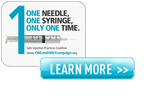Survivor Stories Blog
Real fear in South Korea Hepatitis C outbreak

Prior to my 2009 Hep C infection I paid little, if any, attention to issues of safe injection practices, drug diversion or outbreaks. In my ordinary life, I had no concern for such things. In fact, I am not even sure I could adequately define any of those terms prior to the chaos of 2009 and the outbreak in Colorado.
But since, I have kept myself in the know, paying attention to trends, outbreaks and legislation to protect patients. My email inbox and social media accounts are littered with stories, mostly bad, about errors in patient care. I truly hope that some of the initiatives I have become a part of will put a stop to most of these incidents. However, in preparing for every situation in an attempt to prevent these events you will find a tale so far fetched you want to read the facts 2 or 3 times just to insure what you initially thought you heard was correct. Read more
Learning from our Mistakes: A New Model of Malpractice Resolution

“Dear sir or madam: you have been potentially exposed to Hepatitis C, Hepatitis B and HIV through unsafe practices by your healthcare provider. Please come to our facility to be tested.”
Those were the opening sentences of an official letter that I received from the Nebraska Health Department in 2002.
Thus began my involvement in malpractice litigation as a plaintiff.
But through this experience, we have developed a new model of malpractice resolution – one that requires not only compensation for the victim, but also safeguards the welfare of the community through remediation of medical error.
I was honored to share this model in a TEDx Omaha Talk last month. Please take a look at the talk, share it with your network, and join our campaign by following HONOReform Foundation’s Facebook page!
“If this can happen at Mass General, it can happen anywhere”

Last week, in a blog I wrote on the patient notification in Utah, a situation that is directly related to drug diversion, I mentioned the recent fine levied against Massachusetts General Hospital by the Drug Enforcement Agency.
If this can happen at Mass General, many of us thought, it can happen anywhere. And, sadly, it does.
Among the many acts of drug diversion mentioned in the Settlement Agreement, which is part of the public record, are incidents that involve improper use of injections.
Here is the entire article from the September 28 Boston Globe: “Mass General to pay $2.3 million toresolve allegations of drug diversion,” written by staff writer Travis Andersen.
Read more
4800 Utah Patients could have been exposed to Hepatitis C through Unsafe Injections

It was revealed late last month that nurse Elet Neilson, also known as Elet Hamblin, who has a confirmed case of hepatitis C, was fired by McKay-Dee Hospital of Ogden, Utah in November 2014 (“Hospital acting cautiously,” Oct. 31). At least one of the 4,800 patients who had contact with this nurse during her tenure at the hospital, June 2013 to November 2014, has been infected with the same genotype of hepatitis C as Neilson.
On behalf of HONOReform, a national patient advocacy organization with a focus on safeguarding the medical injection process, I join these patients and their family members in hoping and praying that none of these patients has been infected with this life-threatening disease. I encourage all of these patients to contact the Utah Department of Health and get tested. Read more
Just Google “CDC Drug Diversion”

Drug diversion, “anytime prescription drugs are obtained or used illegally,” is like climate change, in a way. In our experience, most people either do not want to believe it exists or cannot believe it exists. When you start to tell them about it, they close their ears. It’s not that they are rude or there’s a short attention span. It’s just too frightening—unexpected and baffling—too much for them to take in.
We are not in the business of creating wariness, mistrust or fear. We are simply in the business of safeguarding the medical injection process. One of the ways that drugs are diverted in healthcare systems or clinics is through improper injections.
Oftentimes—at least three times that we are aware of, three outbreaks in which multiple patients were infected with hepatitis C—an addicted, infected healthcare worker will inject medication prescribed to a patient into himself or herself, refill these vials with saline then put them reuse them.
If there’s even a speck of infected blood in that injection device, the patient who receives this injection could become infected. Also, the patient is not receiving the proper dose of prescribed medication.
When it comes to drug diversion, there are many overlapping patient safety and worker safety issues. Drug diversion has to be prevented. And, to prevent the problem, to really mobilize to prevent this problem, we need a clear, consistent and acknowledged definition of the problem.
Once again, it’s CDC to the rescue!
Just Google “CDC Drug Diversion,” and the ongoing problem is made clear. On the CDC page titled “Risks of Healthcare Associated Infections from Drug Diversion,” there are sections titled “Outbreaks,” “Prevention Resources,” “Enforcement Agencies,” and much more.
We have touted this work before, this extraordinary ongoing science and research collection, but it bears repeating, especially as we are working toward gathering for a national meeting on drug diversion prevention in early 2016.
The problem is clear, just a click away. We encourage all affected agencies and organizations to forge past the denial that often develops around this subject and work together to develop a plan and take action.
Methodist Monday – Leah’s perspective

Leah Mittermeier, a Junior Level Nursing Student at Nebraska Methodist College, shares her perspectives on injection safety
Hearing Evelyn McKnight’s story really put into perspective what could go wrong if safe injection practices don’t take place. As a nurse I would feel so much shame in knowing my actions threatened people’s lives. I want to be as knowledgeable as possible with injections to ensure every patient I come in contact with is safe.
Being a patient safety advocate means speaking up anytime you see anything that could put a patient in danger. I know that it could be awkward confronting a colleague who was practicing unsafely, but at the end of the day, the patient’s safety and well being should come first. It is our responsibility as nurses to speak up for our patients. They might not realize that an unsafe practice is going on, so it is our responsibility to be on watch for anything threatening to the patient.
I’m very inspired to meet someone who had such a terrible experience and turn it into a learning opportunity for the world. I was impressed how calm Evelyn McKnight is after the experience and the fact that she doesn’t seem to hold grudges against the people involved.
Lesson learned? Medical office reopens after Hep C outbreak

Earlier this year, I commented on the closure of a medical office in Santa Barbara for various infection control violations. It was in the first half of the year and I was feeling hopeful because in 2014 none of the investigations which took place were found to have any infectious disease transmissions. And then in early April news spread the office of Dr. Allen Thomashefsky’s was being investigated.
I felt it important to report again on this situation almost 6 months later as the office was given the approval to re-open last month. Am I disappointed that his practice was able to stay open in Oregon with certain restrictions in place? Am I saddened that this California office was able to be re-opened? Not as long as the proper procedures are implemented.
Read more
Reused syringes causes infection control breach in New Jersey

Last week, reports of a nurse administering flu shots to 67 employees in New Jersey was found to be reusing syringes. While the risk for transmission appears to be low in this incident, it is yet another reminder about how easy the episode of exposure for an infectious disease can be. One shortcut taken either to save time or money can put patients at risk for HIV, Hepatitis B or C.
More than 150,000 patients have been told, over the last 10 years, they needed to get tested following a syringe misuse to include syringe reuse. Despite the protocols put into effect by the CDC, we continue to hear stories of patients put into harm’s way.
Read more
Renewed Call to Action on Worldwide Injection Safety

Steve Langan, director of HONOReform recently attended the World Hepatitis Summit, hosted by the World Hepatitis Alliance. Following is his report.
I am grateful for the opportunity to represent HONOReform and our advocates and stakeholders at the inaugural World Hepatitis Summit earlier this month in Glasgow. I commend the leadership and staff of the World Hepatitis Alliance—Charles Gore, Raquel Peck, Su Wang, just to name a few—who put together a thoughtful and comprehensive meeting.
About 700 of us attended, representing 90 countries. It was a thrilling meeting. I reconnected with old friends and allies and met a lot of people from all over the world who share the desire to prevent and treat viral hepatitis.
According to the WHA, 400 million people are affected with viral hepatitis. Almost a million and a half people throughout the world die every year as a result of being affected by viral hepatitis. It’s the seventh leading killer in the world. Still, it seems that many people remain nonchalant not only about the disease itself but by its most common form of transmission in developing countries—through the medical injection process.
Earlier this year, Evelyn McKnight and I attended the Safe Injection Global Network meeting at the World Health Organization. Evelyn shared her powerful story. The WHO made a commitment to focus on encouraging developing countries—India, Egypt and Uganda, as a starting place—to only use single-use injection devices and to put these one-time-use devices in to play by 2020.
This one fact alone is, to us, a sufficient call to action: Up to 70 percent of the infections of viral hepatitis in India are transmitted through healthcare.
This call to action makes me think of the men and women in the villages west of Delhi. We had the opportunity last year to visit India and meet patients and their family members who were infected with viral hepatitis during healthcare. Watching Evelyn McKnight talk with these patients—mediated by a translator, but the emotions were universal—is one of the most memorable moments of my career.
For them, and for the many other patients throughout the world who go to the doctor and come out with an injection of viral hepatitis, we encourage the WHO and its many partners—governments and industry, in particular—to renew the commitment to injection safety in developing countries.
We have said it before but we will say it again: No person should go in to a medical facility for treatment and leave with an infection of viral hepatitis. Not in 2015. Not with all of the resources and materials that can easily, and affordably, be put in to play.
Please, tell your nurses

Today we are pleased to share the insights of Marilyn Cahalane, RN BSN on the potential exposure to sharps injuries that housekeeping staff face.
Marilyn’s one minute video
Hi, I’m Marilyn Cahalane. Im a retired nurse after 44 years of practice.
Oftentimes I would hear from my housekeeping people, “Please, please tell your nurses.”
Anytime after a code or a very critical situation that occurred in a patient room, my housekeeping people, would be right there – wonderful people – to clean up the room after we had left it a mess.
Needles were stuck in mattresses, thrown on top of the covers, thrown in the wastebasket, even dropped on the floor.
My housekeeping people came to clean and would be inadvertently stuck.
Please, we have safety devices that take care of human error issues like this. Please research that and enforce it within your immediate surroundings. Thank you.





